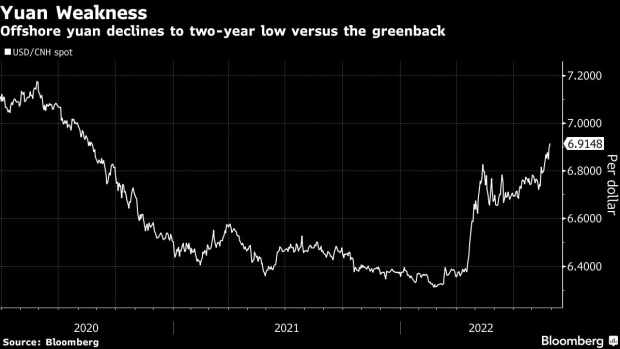Aug 28, 2022
Yuan Extends Drop to Two Year Low, Putting PBOC Fixing in Focus
, Bloomberg News

(Bloomberg) -- China set its daily reference rate for the yuan at a stronger-than-expected level for a fourth day, after the offshore currency tanked to a two-year low on the back of a hawkish Federal Reserve.
The People’s Bank of China set its fixing 96 pips stronger than the average forecast in a Bloomberg survey with analysts and traders. The reference rate, which limits the onshore yuan’s moves by 2% on either side, was set stronger after the offshore unit slid past 6.9 for the first time since 2020.
Risk assets sold off globally after Fed Chair Jerome Powell last week at the Jackson Hole symposium flagged the likely need for restrictive monetary policy for some time to curb high inflation. The PBOC had been capping the yuan’s losses in the run-up to the event by setting stronger-than-expected currency fixings. At least two banks that submit fixing quotations tweaked their models to lean against the yuan weakness, according to people familiar with the matter.
“Another stronger than expected fixing today is a clear signal from the authorities that they want to stem yuan depreciation pressure and stabilize the currency to prevent it from weakening further,” said Khoon Goh, Head of Asia Research at Australia & New Zealand Banking Group.
The yuan is under pressure to fall as a hawkish Fed puts the US central bank’s policy increasingly at odds with that of China, which is keeping an accommodative stance to boost its economy battered by Covid restrictions and turmoil in the property sector. The economy is projected to grow just 3.5% this year, down from a previous forecast of 3.9%, according to Bloomberg’s latest quarterly survey of economists.
Goldman Sachs Group Inc and Bank of America Corp. see the yuan to falling to 7 per dollar, a level unseen since July 2020. The onshore yuan fell 0.6% to 6.9135 per dollar while the offshore unit dropped 0.4% to 6.9217 at 12:12 pm in Hong Kong. Monday’s fixing was set at 6.8698 per dollar while Thursday’s fix was 120 pips stronger than the forecast, the widest gap since February 2020.
Further Steps
The yuan’s decline has the market closely watching the extent of currency intervention from China especially as the dollar’s surge has dragged most Asian currencies lower.
The pace of yuan’s depreciation is not as bad as it was in April, according to Tommy Xie, head of Greater China research at Oversea-Chinese Banking Corp. So “PBOC could be a little bit more patient,” he said, adding that the PBOC could use old play-books like lowering the foreign-currency reserve requirement ratio and verbal intervention in case losses deepen.
The PBOC has kept a mostly hands-off approach with respect to currency management this year. It slashed the foreign-currency reserve ratio in April as the onshore yuan fell more than 4%. It’s on track for a 2.5% drop this month.
China has been more tolerant of yuan volatility compared with in the last round of yuan depreciation in 2018, Guan Tao, a former official at China’s FX regulator State Administration of Foreign Exchange, wrote in an article in local newspaper China Business News. However, authorities will reintroduce policies to correct the market if they spot the risk of a cyclical herd effect or yuan bears overshooting in the future.
(Updates throughout.)
©2022 Bloomberg L.P.






